Controversial Creative NZ Funding Rejection Made Public
Written by

Creative New Zealand (CNZ) has once again gone beyond its usual practice in the aftermath of the Shakespeare Globe Centre NZ (SGCNZ) funding controversy - making their full response public on Wednesday (2 November), which includes the names of some of their independent assessors.
One of the four Toi Uru Kahikatea clients who were unsuccessful in their application for the next three year funding cycle, SCGNZ’s campaign whipped up a maelstrom of support that eventually led to the Ministry of Education stepping in to agree to work with them last month.
That led to CNZ making an out-of-the-ordinary statement at the time to explain their side of the story and to call for an end of the abuse being sent to its frontline staff.
Several paragraphs from the rejected application - which was for funding for an administration role, rather than directly for the programmes that go into the schools - found their way to the public eye, causing much of the local and international headlines that drew so much ire and debate.
The most highlighted being “This genre was located within a canon of imperialism and missed the opportunity to create a living curriculum and show relevance to the contemporary art context of Aotearoa.”
Why now?
In the face of unrelenting requests for the information from the media, including Official Information Act (OIA) submissions, CNZ has put the full report on their website. CNZ notes that SGCNZ has been consulted on its release.
For those who haven’t gone through such a process before, the report will be an insight into the mechanisms and the way a failed funding bid is communicated.
The 15-page OIA response (which can be read here) shares information originally provided directly to SGCNZ “in the spirit of openness and transparency and to help them understand how the Arts Council came to their decision”, CNZ states on its website.
CNZ also says it hopes that “by publishing the document in full, readers can gain a clearer contextual understanding of the material. It provides more details around the Arts Council’s decision to decline SGCNZ’s proposal and it includes assessors’ comments within the context they were written.”
What's missing?
Some of the information has been redacted under sections of the OIA “to protect the privacy of natural persons and information subject to an obligation of confidence…Where information was withheld, no public interest has been identified that would outweigh the reasons for withholding it.”
That redacted information includes the names of five of the independent assessors used through the wider application assessment process - with 31 other assessors being named on the list - and much of the internal assessment for SGCNZ’s organisational financial viability, which is described as “perceived to be exposed to financial risk.”
The report confirms that the unnamed independent assessors both gave strong responses to SGCNZ’s unsuccessful application - a common criticism among organisations that fall out of funding favour.
In their explanation, CNZ stated the proposal was “not strong” and the organisation was “quite paternalistic.” Included in its rationale, “the proposal did not demonstrate the relevance to the contemporary art context of Aotearoa. The panel was concerned about number of theatre organisations in the round and questioned the role and relevance of Shakespeare in Aotearoa.”
That relevance was also questioned by the independent assessors, as well as suggesting SCGNZ’s application needed “a more robust self-examination of its practice and functions.”
CNZ also added “all parties agree that this organisation delivers to CNZ aspirations (namely opportunities for young people to participate and experience the arts) and that a gap will be created by its exit from the Kahikatea programme.
“But there are concerns about the relevancy and future focus of this proposal that challenged peer assessors’ confidence in the organisation’s capacity to deliver strongly.”
It was also outlined that SGCNZ’s rejection was “based on them having a weaker delivery to assessment criteria than others.”
Why this conversation is usually private
While explaining why they don’t usually make this level of information readily available, CNZ states “We want to respect the privacy and mana of those who aren’t successful in any funding round.
“Many good applications and talented artists miss out on contestable funding because of the high demand.
“We understand that people are disappointed when their applications are declined and respect their right to speak about it publicly.
“When we receive media requests about declined applications, we do our best to provide factual information while respecting the privacy around certain parts of applications.”